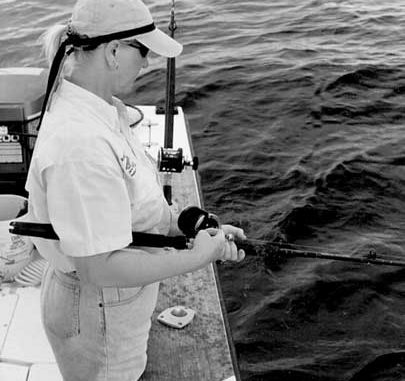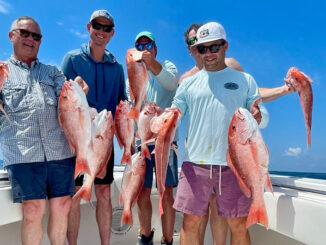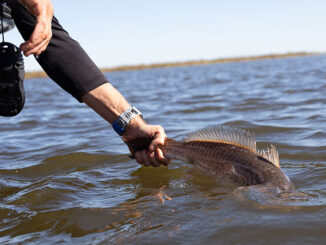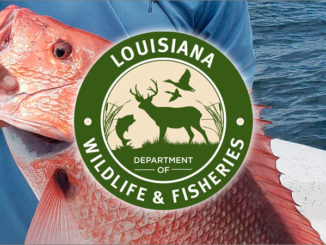
As the season winds down, the action should wind up this month.
Red snapper fishing, which has been slower-than-expected all summer long, is now drawing to a close. The season ends Oct. 31, and will not reopen until April 21, 2004.
The season so far has been described as “lackluster,” “disappointing,” and “$%$&^#@,” depending on who you asked.
Actually, this year the season started out with a bang. Boats were coming back to the docks with limits of nice fish, and the prospects for a great season seemed excellent.
That euphoria lasted for one week, and then the bottom fell out. The fish vanished. Boats went from catching limits to barely catching any, and it has remained that way all summer long.
But there’s been an interesting phenomenon. For the past three years, just as the red snapper season was drawing to a close, the action suddenly picked up. The fish started showing up again at offshore rigs and reefs, in good sizes and decent numbers. Three years in a row that has happened, and it seems to be happening again this year. Captains and private anglers are reporting that, since mid-September, they’ve noticed better catches of the highly prized fish.
I recently made a trip out of Grand Isle with Capt. Bobby Terrebonne to see if we could find some of the hitherto elusive fish. The offshore trip was set up for a group of us outdoor writers by Buggie Vegas, over at the Bridgeside Marina, to coincide with our annual Louisiana Outdoor Writers Association convention. Also aboard was Jerald Horst, assistant professor of fisheries for LSU AgCenter/Sea Grant, and Susan Gros, fisherwoman extraordinaire, who holds 13 IGFA women’s saltwater flyfishing records (and another one pending) and 11 state records. We piled into Terrebonne’s 25-foot Mako, and headed out the pass toward the South Timbalier rigs.
Twin 200-horsepower Yamaha outboards pushed us offshore at a quick clip, and we settled in for the 30-mile ride.
“There’s only three things to remember when you fish with me,” Terrebonne said, shouting to be heard over the whine of the motors. “One, if a big fish pulls you overboard, the first hand you stick up out the water better have a rod and reel in it. Two, if the fish is still on the line, we’re going to play him in next. Three, tread water until we get back to you.”
His thick Cajun accent drew a chuckle from the three of us. I think he was only kidding.
The first rig we hooked onto wasn’t as large as what I typically expect.
“It’s been my experience,” Terrebonne explained, “that the smaller rigs hold smaller fish. They might be plentiful, but they’re undersized. But this small rig has been the exception. I’ve pulled some real nice snapper up from about 50 feet deep right here at this rig.”
We baited up our hooks with Terrebonne’s favorite snapper bait — live croakers — and sent them 50 feet down. We had strikes within seconds. Most of the hits came from triggerfish, who consider croaker bellies a delicacy. Our baits came up mauled, mangled and sans stomachs.
But every now and then, we hooked a good fish. Gros reeled in the first catch of the day, a hefty mangrove snapper, and then proceeded to repeat that performance a couple more times before either Horst or I got in on the action.
The hits fizzled completely after about an hour, but by then we had some nice fish in the boat. Terrebonne moved us on to a bigger rig. For the rest of the day, we rig hopped. We’d catch a few mangrove snapper at one rig, some nice red snapper at another, a combination of fish at yet another, and a few cobia thrown in for good measure. Virtually every rig provided plenty action, bent rods, good fun and sore arms.
Red Snapper Research
Horst says red snapper is one of the most highly researched fish in the Gulf. And yes, there has been a lull in red snapper fishing for the past two years, from Venice to Grand Isle. The lull began both years about a week after the season opened.
But this year’s lull has been longer and deeper, he said.
“The overall numbers of red snapper are down, but the sizes are not down,” he said.
Furthermore, rig divers have assured Horst that there are still plenty of big red snapper hanging out at the rigs and reefs. Why aren’t they biting?
“That’s the mystery,” Horst said. “There are so many factors to consider. Is it a dead-zone phenomenon? Possibly, because there’s still a lot of unknowns about the dead zone. It can stretch across the bottom of the Gulf for large distances, but extend only a few inches high off the bottom. Or it can stretch from the bottom to the surface.
“We know that red snapper can suspend above the dead zone. We also know that red snapper feed almost exclusively off the soft bottom of the Gulf. We know that their diet consists of bottom-dwelling critters — king shrimp, mud eels, etc. And not just bottom, but soft bottom — mud.
“So that tells us they really don’t suspend along the rigs to feed. They probably do it for protection or because of some other instinct. So when fishermen dangle baits in front of them alongside a rig, they may or may not feed, because, keep in mind, rigs are not their natural feeding ground. And they might not be as opportunistic as other predators.
“There are other considerations. For instance, we know that some of the best red snapper fishing of the year was done in the winter months, at shallower rigs. That’s why many private and charter fishermen were upset at the closure of the season throughout the entire winter months.
“Right now, to find red snapper, you have to head for rigs and reefs in 60 to 300 feet of water. Lots of them are caught at rigs in 60 to 90 feet of water, but generally, the hotter it is, the deeper they go.
“But in winter, they come in closer, into the cooler water. That leads us to ask more questions. Have the fish moved into deeper water during the hot summer months? Are they still there, but do they not feed as aggressively?
“And here’s another interesting tidbit. The eastern Gulf waters, off the Florida coast, are experiencing a resurgence of red snapper activity right now. In fact, for the past three years, the same years we were experiencing a lull in the western Gulf, they were having a boom. Coincidence?”
A troubled horizon?
On April 25 of this year, four environmental groups — The Gulf Restoration Network, Reef Keeper, International, Oceania and the Ocean Conservatory — charged the Gulf Council’s management of red snapper as being inadequate. They want the National Marine Fisheries Service to assume oversight.
Topping their list was the charge that the Gulf’s recreational fishermen took more than 1 million pounds over their quota last year, and could be doing it again this year. Commercial fishermen would never be allowed to get away with that, they claim.
“The recreational limit for red snapper applies to the whole Gulf of Mexico — Texas, Louisiana, Florida, we’re all thrown in the mix,” Horst explained. “No state has an individual limit, there’s just one recreational limit, and it applies to all the Gulf. The season applies to everyone, but naturally some years some states will have a better season than others.”
To compensate for going over the quota, the environmental community wants to reduce the overall quota of red snapper by one-third — from 9 million pounds to 6 million. Plus, they want to take away one-third of the remaining quota to compensate for last year’s over fishing.
If enacted, such legislation could reduce the red snapper season to a matter of weeks, instead of months. Such news leaves even more of a sour taste in the mouths of Louisiana anglers, who are already suffering through three years of scarce snapper.
Not all gloomy
Perhaps the resource could be managed better. Perhaps the season could be staggered, instead of closed for 6 months in a row, especially since the closed months are some of the best months for fishing. Perhaps each Gulf state could have its own quota. Nobody has all the right answers, but anglers want to see the continuation of this great-fighting, great-eating fish in our Louisiana waters.
“If you’re going to chase red snapper out of Grand Isle this month,” Terrebonne said, “then I’d head to the South Timbalier 80s, the Grand Isle 90s, Grand Isle 82 and Ewing Banks 305.
“I’d vary my depth from between 50 and 100 feet, and I’d use live croakers if I could get them, or pogies, squid or sardines. You’ll catch some nice mangroves, and you should find some good red snapper also.
“But the key factor in October is going to be the weather. If the winds will cooperate, then we should see some good catches of red snapper coming back to the docks this month.”
Whatever hopes or plans you’ve had for red snapper fishing, you’d better act on them now because you won’t get another chance for six months.
Capt. Bobby Terrebonne can be reached at (985) 787-2481.


